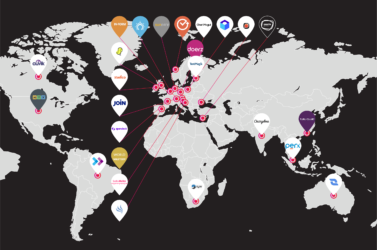If you are a founder, you are smart enough to do a financial plan.
Christoph Janz
If he could, Christoph Janz, Managing Partner of Point Nine Capital, would probably help every SaaS company in the world create their financial plan. Unfortunately, he cannot. Christoph and the Point Nine team have been helping portfolio companies create financial plans since the firm was established back in the middle of 2011. For the rest of the SaaS companies out there he has created two financial plan templates. One was made in 2012 and the other in 2016, both of which he posted on his blog: The Angel VC.
They remain some of the most consumed content Christoph has ever done. The first template is somewhat simpler and is based on the very first financial plan Christoph did for Zendesk. It’s for SaaS companies just starting up. The second is an improved and more sophisticated version, which is relevant to more mature SaaS companies.
While these templates have massively reduced the uncertainties with creating a financial plan, the art of plotting assumptions and projections with confidence remains a challenge for most founders. It had taken Christoph a few iterations to complete Zendesk’s financial plan and be confident with it. It’s because what lays in the heart of a good financial plan is an immaculate understanding of what drives growth. What he ended up putting together helped the Zendesk founders to convince their first Series A funder, Devdutt Yellurkar from Charles River Ventures to write a check in late 2008.
In this exclusive interview with Christoph, you will learn where to get started with your financial plan, how to make assumptions once you run out of existing data, what are common mistakes to avoid, and what are some useful benchmarks to keep in mind for your metrics.
Plot the right existing data
Christoph had met Zendesk in mid-2008 and became their first angel investor. Up to that point the Danish company had bootstrapped its way to product-market fit, “a term that wasn’t very well known yet at the time,” as Christoph says. He has since then tried to get his head around it and has written two posts about it.
It had been around six months since Zendesk had launched their product and the company was already seeing traction and believed in the potential for growth. It was time to set the groundwork for scaling. To do that, Zendesk would need a much bigger injection of money to be able to cover the costs related to what was coming next. One of the critical elements to getting that sort of cash, which at the time would fall under Series A, was producing a viable financial plan.
Christoph had never done a financial plan for a B2B SaaS company but had some experience with financial planning for consumer Internet startups, so he took over the task to let the founders focus on running the business. “I had no idea about SaaS and what sort of SaaS metrics I would have to show.” Nobody in Europe was investing in SaaS so there was no guidance out there. Christoph assumed a Series A funder would look for proof points like growth and revenue.
Nowadays we have so much data about what metrics VCs look for, but back then we didn’t even have names for them.
Christoph opened an Excel spreadsheet and started from scratch. “What are the drivers of the business?” he asked himself.
On the first line, he wrote Website Visitors. “At the time Zendesk was very much an online business, almost like a consumer company where the top of the funnel consists of people coming to the website.”
Some of them were signing up, and a part of those were converting into paying customers, which Zendesk had a few handfuls of. Christoph took that and the conversion rate it represented. He had no idea what sort of benchmark would be considered healthy or attractive.
A conversion rate anywhere between 5 and 15 percent is good and looks assuring nowadays.
Christoph then looked at the model for acquiring new signups, including organic growth and paid marketing. He put in the costs for staff, administrative and other expenses.
The first template he put on his website was very much based on that financial plan he had done for Zendesk. It is suitable for a company which markets a SaaS solution via its website, offers a 30-day free trial, gets most of its trial users organically and through online marketing and converts them into paying customer with very little human interaction.
“The key drivers are organic growth rate, marketing budget, and customer acquisition costs, conversion rate, ARPU, and churn rate,” he wrote in the blog post accompanying the plan.
There was enough predictability and repeatability in Zendesk’s existing data, to be able to plot the assumptions, projections and plans to create a plan that was plausible.
What gave Christoph the confidence boost with that initial plan? And most importantly what would give you the boost as you prepare your business plan? This is what Christoph shares.
Understand growth drivers
To create predictions that are believable Christoph says you need to understand the trends in your existing data, what has driven growth so far and what will likely drive it forward. Don’t base it on what you want to achieve alone. “We all want to grow 10x, but that doesn’t mean that is going to happen.” It’s wishful thinking that will undermine you. Because in the end, the financial plan is the proof you have thought about growth long and hard and have realistic notions about it. It shows you understand how conversion works and what you need to do.
A few tips what to do:
- Have an attribution model. You will need to know where the sign-ups are coming from. Christoph recommends using a tool like Convertro. It requires a significant investment, so a simpler way of figuring out how sign-ups come about is to track the first click and last click. It will tell the story of how people first found you and what convinced them to go to your website and how long it took them to give you their email. “This is already more than most startups do.”
- Talk to customers. Ask them how did they hear about you, what convinced them to give you a shot?
- Differentiate traffic. Look at website and application traffic separately because otherwise, your numbers will be deceiving.
- Look at organic growth. Differentiate how many sign ups you are getting organically in comparison to paid acquisitions. Organic can be much more unpredictable and varying, so it’s important to be very conservative as you plot this one in your growth predictions.
As you study all this, ask yourself: Based on everything I know, is there a reason to believe this will increase and keep increasing at the same rate. Will it improve by doing certain marketing activities? And if it does, how? Answering either of these isn’t easy. Christoph recently wroteon the subject.
Christoph warns against a few common mistakes:
- Not recognisingthe low hanging fruit
As you first start off, you are capturing a lot of low hanging fruit, especially with paid advertising. And the low hanging fruit will run dry eventually. Assuming that by doubling the budget on ad spend, will get you double the customers is a pitfall you may find yourself in. You have to understand that keyword search volume changes all the time, prices go up, and words get more competitive. Don’t grow the budget by a factor of X, setting the expectation that the same factor will apply to the growth of customers.
- Extrapolating exponential growth
Regardless of whether you are picking up low hanging fruit or going through exponential growth for some other reason, don’t assume it will carry on the same way in two years time. Growth is rarely truly exponential, but rather linear or step by step. The only sustainable way to reach true exponential growth is to have embedded virality into your product whereby people merely using your product are automatically referring you forward. “A good example is Typeform.” Unless you are confident of that viral effect, do not put such an exponential growth in your financial plan.
How can you forecast growth more realistically? How do you know how long hyper-growth will last?
- Correlate every spike with an event. Was it driven by a PR activity you did, a referral program you ran, or are you still in the early days capturing low hanging fruits? If it’s any of these, treat with caution and be conservative in your projections.
- Look realistically at the market size. Based on your target customer, how many companies face the problem you are solving. Using industry databases is a useful place to start.
- Investigate the metrics behind sustainable activities. Content marketing is a good example. Look at the amount of content you have done and how it’s driving customers and conversions.
- Underestimating costs
Another common mistake Christoph has seen again and again is assuming that revenue growth goes through the roof, but costs increase very little. What you will project in three years will seem very unreasonable if that is the case. “No one will believe a 90% EBITDA margin.”
Underestimating costs is a common occurrence among founders, a product of their very nature: inherently optimistic they suffer from the bias that things will work out better than expected. They would not have started companies in the first place otherwise. Either way, they should think about the true costs of building a business and realise that costs grow with revenues. Sometimes that is proportionate, but sometimes it’s not.
Common underestimations with costs:
- Customer support. The cost of supporting a large customer base will be higher than you imagine.
- Headcount in all other departments. Founders often underestimate how many people they will need in their organisation. The beauty of a software business is that serving 100x more customers doesn’t require 100x more people, but requires more than many founders think.
- Customer acquisition costs. Many founders overestimate the potential of organic growth and all the costs that go into acquiring a new customer.
- Have a very clear number of your Customer Acquisition Costs.
Make sure you include all costs associated with customer acquisition. It may not be as obvious so you need to think this through. Track the impact of various spendings, such as conversion uplift from the customer success or sales teams. If you are spending a lot of money on paid acquisition for lead generation, you should have a multi-touch attribution model in place.
The sales organisation plan
The second financial plan that Christoph created in 2016 included much more detail than the first one. In it he differentiated three separate tier plans. The customers for the Basic and the Pro plans were still coming in predominantly organically or through online marketing. They converted into paying customers with very little human interaction.
The third tier was enterprise. That segment followed a different logic, which was based on the assumption that Enterprise customer acquisition is driven by sales. The key drivers in the Enterprise segment of the model were revenue targets and sales team quotas, adding the assumptions for churn and upsells.
Christoph created a separate tab on the financial plan specifically for the sales organisation growth. “While everyone contributes to the growth of the company, no other department impacts it as much as sales do.”
How do you build a sales plan that is realistic? How do you know how many people to hire and when? Christoph believes you should start from what your revenue goals in 2 years time are and work backward.
- Do sales yourself for a while. It will help you understand your market and how it responds to your proposition. That is the only way to know what is possible. Don’t delegate the sales from the start. Fail a few times, refine the sales pitch and the deck, try again. Only once you have a feel for the market, start thinking about the sales organisation. “Your first and second customers shouldn’t be acquired by a salesperson you have hired.”
- Plot a quota for the ARR each sales executive needs to bring per month.You will have to assume that on average most of them will meet their quota. In reality, some won’t meet their quota and some will exceed it, and it’s why an average figure is relatively safe. While the numbers that Christoph uses are dummy, they are based on a benchmark study he has used in a previous post. The most important thing about the quotas is that they need to represent a scenario where you are a profitable business.
- Figure in the onboarding time. As you plot the data, you need to take into consideration the fact that each salesperson takes time to ramp up fully. Christoph’s assumption is that on average people get 100% productive in month 4 and are somewhat productive in the first three months.
- Understand the ROI for Customer Acquisition Costs (CAC). As you input all the costs for acquiring a customer, it’s important to be honest about whether you are getting the right return on that investment. Christoph recommends looking for 5x ROI on your customer acquisition costs in the enterprise on the way from Series A to Series B.
Before you submit the financial plan
A plausible financial plan will get you much closer to the desired funding you are after. It will also help you understand what drives your business, an exercise which is always helpful. But before you submit it to a funder, Christoph would suggest you do your homework in evaluating your funder.
You are going to spend the next ten years with a VC so it better be someone you would like to have a call with or meet up with.
A few things to do to evaluate a potential investor:
- Date your investor before marrying them. Investors are good at selling themselves so you need to get references. Take as many reference calls as you can.
- When you do reference calls, ask the right questions. People are polite by default, and they won’t give out so think about what are the questions you are going to ask
Christoph recommends asking the following questions:
- How did the investor specifically provide value?
- Do you remember 2-3 things that they did for you?
- When you were going through something rough, how did they react?
- How would you rate that investor, versus other investors?
You are doing all this, because in a difficult situation, “the role of the investor is to calm the founders down and not to add even more stress.” You need to find that kind of people. Like Christoph himself who goes out of his way to help founders assess tough situations, use his networks to provide support, and cheer founders. Good investors do that all the while increasing the ambition and confidence of the founder, encouraging them not to sell the company too early, and giving a hand with something like financial plans.




